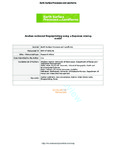Aeolian sediment fingerprinting using a Bayesian mixing model
| dc.contributor.author | Gholami, H | |
| dc.contributor.author | Telfer, Matt | |
| dc.contributor.author | Blake, William | |
| dc.contributor.author | Fathabadi, A | |
| dc.date.accessioned | 2017-09-05T14:07:34Z | |
| dc.date.available | 2017-09-05T14:07:34Z | |
| dc.date.issued | 2017-08-16 | |
| dc.identifier.issn | 0197-9337 | |
| dc.identifier.issn | 1096-9837 | |
| dc.identifier.uri | http://hdl.handle.net/10026.1/9893 | |
| dc.description.abstract |
<jats:title>Abstract</jats:title><jats:p>Identifying sand provenance in depositional aeolian environments (e.g. dunefields) can elucidate sediment pathways and fluxes, and inform potential land management strategies where windblown sand and dust is a hazard to health and infrastructure. However, the complexity of these pathways typically makes this a challenging proposition, and uncertainties on the composition of mixed‐source sediments are often not reported. This study demonstrates that a quantitative fingerprinting method within the Bayesian Markov Chain Monte Carlo (MCMC) framework offers great potential for exploring the provenance and uncertainties associated with aeolian sands.</jats:p><jats:p>Eight samples were taken from dunes of the small (~58 km<jats:sup>2</jats:sup>) Ashkzar erg, central Iran, and 49 from three distinct potential sediment sources in the surrounding area. These were analyzed for 61 tracers including 53 geochemical elements (trace, major and rare earth elements (REE)) and eight REE ratios. Kruskal–Wallis H‐tests and stepwise discriminant function analysis (DFA) allowed the identification of an optimum composite fingerprint based on six tracers (Rb, Sr, <jats:sup>87</jats:sup>Sr, (La/Yb)<jats:sub>n</jats:sub>, Ga and δCe), and a Bayesian mixing model was applied to derive the source apportionment estimates within an uncertainty framework.</jats:p><jats:p>There is substantial variation in the uncertainties in the fingerprinting results, with some samples yielding clear discrimination of components, and some with less clear fingerprints. Quaternary terraces and fans contribute the largest component to the dunes, but they are also the most extensive surrounding unit; clay flats and marls, however, contribute out of proportion to their small outcrop extent. The successful application of these methods to aeolian sediment deposits demonstrates their potential for providing quantitative estimates of aeolian sediment provenances in other mixed‐source arid settings, and may prove especially beneficial where sediment is derived from multiple sources, or where other methods of provenance (e.g. detrital zircon U–Pb dating) are not possible due to mineralogical constraints. Copyright © 2017 John Wiley & Sons, Ltd.</jats:p> | |
| dc.format.extent | 2365-2376 | |
| dc.language | en | |
| dc.language.iso | en | |
| dc.publisher | Wiley | |
| dc.subject | sand provenance | |
| dc.subject | aeolian sediment | |
| dc.subject | Markov chain Monte Carlo | |
| dc.subject | fingerprinting | |
| dc.subject | uncertainty | |
| dc.title | Aeolian sediment fingerprinting using a Bayesian mixing model | |
| dc.type | journal-article | |
| dc.type | Journal Article | |
| plymouth.author-url | https://www.webofscience.com/api/gateway?GWVersion=2&SrcApp=PARTNER_APP&SrcAuth=LinksAMR&KeyUT=WOS:000414348200011&DestLinkType=FullRecord&DestApp=ALL_WOS&UsrCustomerID=11bb513d99f797142bcfeffcc58ea008 | |
| plymouth.issue | 14 | |
| plymouth.volume | 42 | |
| plymouth.publication-status | Published online | |
| plymouth.journal | Earth Surface Processes and Landforms | |
| dc.identifier.doi | 10.1002/esp.4189 | |
| plymouth.organisational-group | /Plymouth | |
| plymouth.organisational-group | /Plymouth/Admin Group - REF | |
| plymouth.organisational-group | /Plymouth/Admin Group - REF/REF Admin Group - FoSE | |
| plymouth.organisational-group | /Plymouth/Faculty of Science and Engineering | |
| plymouth.organisational-group | /Plymouth/Faculty of Science and Engineering/School of Geography, Earth and Environmental Sciences | |
| plymouth.organisational-group | /Plymouth/REF 2021 Researchers by UoA | |
| plymouth.organisational-group | /Plymouth/REF 2021 Researchers by UoA/UoA14 Geography and Environmental Studies | |
| plymouth.organisational-group | /Plymouth/Research Groups | |
| plymouth.organisational-group | /Plymouth/Research Groups/Marine Institute | |
| plymouth.organisational-group | /Plymouth/Users by role | |
| plymouth.organisational-group | /Plymouth/Users by role/Academics | |
| plymouth.organisational-group | /Plymouth/Users by role/Researchers in ResearchFish submission | |
| dcterms.dateAccepted | 2017-06-15 | |
| dc.rights.embargodate | 2018-6-20 | |
| dc.identifier.eissn | 1096-9837 | |
| dc.rights.embargoperiod | 12 months | |
| rioxxterms.versionofrecord | 10.1002/esp.4189 | |
| rioxxterms.licenseref.uri | http://www.rioxx.net/licenses/under-embargo-all-rights-reserved | |
| rioxxterms.licenseref.startdate | 2017-08-16 | |
| rioxxterms.type | Journal Article/Review |


